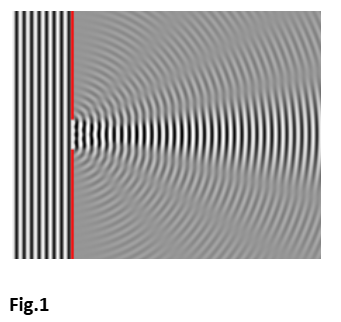Wave Diffraction
Wave Diffraction
This lesson aligns with NGSS PS4.A
Introduction
Diffraction refers to the phenomenon where waves bend around small obstacles or spread out when they pass through small openings. This behavior is especially noticeable when the size of the obstacle or opening is comparable to the wavelength of the wave. Diffraction is a characteristic property of all waves, including sound waves, light waves, water waves, and even seismic waves. In this article, we will explore the nature of wave diffraction, its principles, factors that influence it, and its applications in real-world situations.
What is Wave Diffraction?
The bending and spreading of waves due to diffraction is often accompanied by a change in the direction of wave propagation. For example, when sound waves encounter the edge of a door or light passes through a narrow slit, diffraction causes them to bend and spread into regions where, according to geometric predictions, they should not reach.

The Physics Behind Diffraction
The core reason why diffraction occurs lies in the wave nature of energy propagation. Waves consist of oscillations that transfer energy through a medium. When a wavefront encounters a barrier with an opening or the edge of an object, each point along the wavefront behaves like a new source of wavelets. This concept is known as Huygens' Principle.
According to this principle, every point on a wavefront can be thought of as a secondary source of new waves, which spread out spherically. As these wavelets spread, they interfere with one another, forming a new resultant wavefront.This is why, after passing through an aperture, waves spread out rather than continue traveling in a straight line. The amount of diffraction (the degree of bending and spreading) depends on the relationship between the wavelength of the wave and the size of the obstacle or opening.

Factors Affecting Diffraction
Several factors influence the extent to which waves diffract:
- Wavelength: Diffraction is most noticeable when the wavelength of the wave is comparable to or larger than the size of the obstacle or aperture. For instance, sound waves, which have wavelengths that range from millimeters to several meters, easily diffract around objects like doors and walls. Light waves, on the other hand, have much shorter wavelengths (ranging from 400 to 700 nanometers), so diffraction is less noticeable in everyday situations.
- Size of the Aperture or Obstacle: When waves pass through a narrow slit or aperture that is similar in size to their wavelength, they spread out significantly. If the aperture is much larger than the wavelength, diffraction is minimal, and the wave passes through the opening largely unaltered.
- Wave Type: Different types of waves diffract to different extents. For example, sound waves have long wavelengths compared to light waves, and as a result, sound tends to diffract much more easily than light.
Diffraction in Everyday Life
Some of the most common examples include:
- Sound Waves: We can hear sounds even when the source is not in our direct line of sight because sound waves diffract around obstacles. For instance, when you are standing behind a wall, you can still hear someone talking on the other side, even though the wall blocks the direct path of the sound waves. The waves bend around the edges of the wall, allowing them to reach you.
- Water Waves: In water, diffraction can be easily observed when waves encounter a barrier with a small opening. For example, if you place a barrier with a narrow slit in a ripple tank, the water waves that pass through the slit will spread out in circular patterns. This behavior is characteristic of diffraction and can be used to study wave interference and other wave properties in physics experiments.

- Light Waves: While light waves have shorter wavelengths than sound waves, diffraction still occurs, especially when light passes through very narrow openings. One common demonstration of light diffraction is the double-slit experiment, where light is passed through two narrow slits close to each other. The light waves diffract through the slits and interfere with each other, producing a pattern of bright and dark fringes on a screen, which provides direct evidence of the wave nature of light.
- Radio Waves: Radio waves have much longer wavelengths than light, and as a result, they diffract easily around large obstacles such as buildings or mountains. This is why radio signals can often be received even when there is no direct line of sight between the transmitter and receiver.
Diffraction in Nature
Wave diffraction also plays an essential role in natural phenomena. For instance, rainbows form as a result of the diffraction, refraction, and reflection of light inside raindrops. As sunlight passes through the tiny droplets, it bends and spreads out into its component colors, creating the familiar rainbow arc.
Another example is ocean waves. When waves travel from deep water into shallow water near the shore, they experience diffraction, which causes them to bend toward the coastline. This bending is essential in shaping coastal wave patterns and can influence coastal erosion and sediment deposition.
Conclusion
- Diffraction refers to the phenomenon where waves bend around small obstacles or spread out when they pass through small openings.
- This behavior is especially noticeable when the size of the obstacle or opening is comparable to the wavelength of the wave.
- When waves pass through a narrow slit or aperture that is similar in size to their wavelength, they spread out significantly.
- If the aperture is much larger than the wavelength, diffraction is minimal, and the wave passes through the opening largely unaltered.
Related Worksheets:













